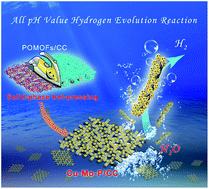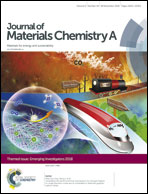Solid-phase hot-pressing synthesis of POMOFs on carbon cloth and derived phosphides for all pH value hydrogen evolution†
Abstract
Designing an all pH value hydrogen evolution reaction (HER) electrocatalyst with low cost and high activity is urgently needed for future energy storage and conversion systems. Metal–organic frameworks (MOFs) with well-defined pore structures and various metal sources provide feasible platforms for the design of efficient electrocatalysts. However, MOFs as crystalline materials are mostly in crystal or powder form, which would hinder their practical application. Herein, polyoxometalate-based MOFs (POMOFs) were synthesized on carbon cloth (CC) through a facile and general solid-phase hot-pressing method for the first time. The thus-obtained POMOFs/CC can be converted into three phase bimetallic phosphides coated with porous carbon on CC through a phosphidation process, show high electrocatalytic stability over a wide pH range (pH, 0–14) and possess excellent HER performance with low overpotential (e.g., 90.5 mV at 10 mA cm−2 in 1 M KOH). Moreover, the POMOFs/CC derived phosphides present high selectivity for H2 production (nearly 100% faradaic efficiency) and ultra-low charge-transfer resistance (0.96 Ω) in alkaline medium, which hold promise for practical applications. This work provides a powerful strategy for the facile production of fast nucleating MOF-derived electrodes with potential for industrial-scale application in energy storage and conversion.

- This article is part of the themed collections: Journal of Materials Chemistry A Emerging Investigators and 2018 Journal of Materials Chemistry A HOT Papers


 Please wait while we load your content...
Please wait while we load your content...